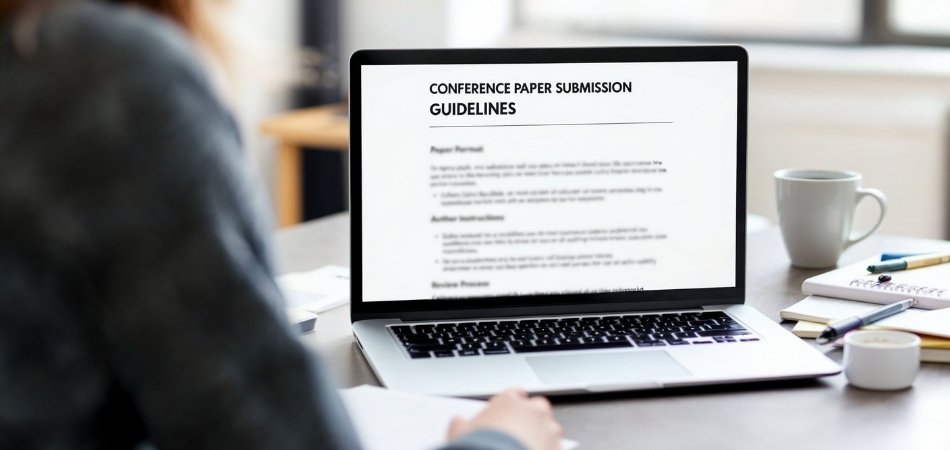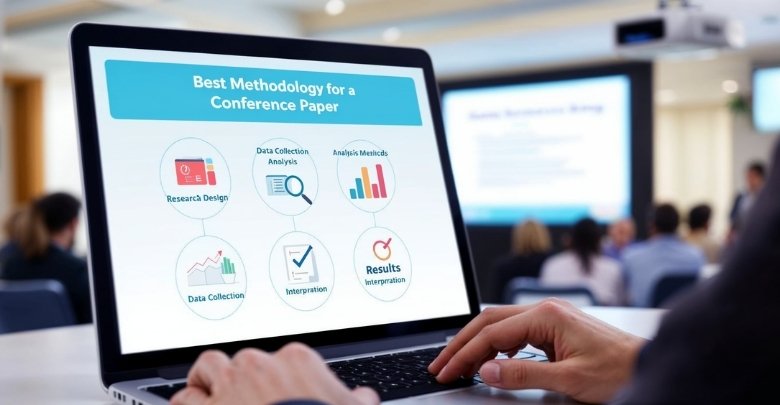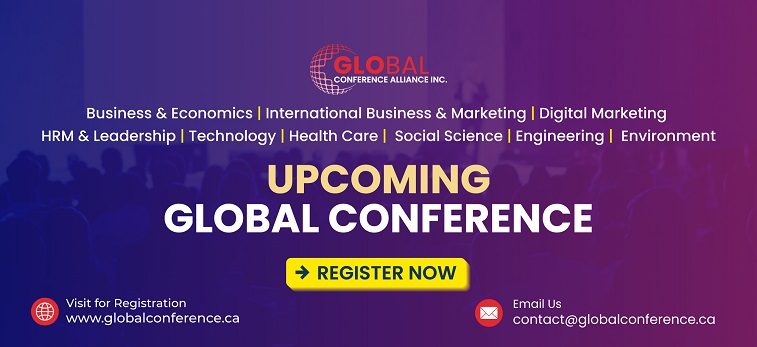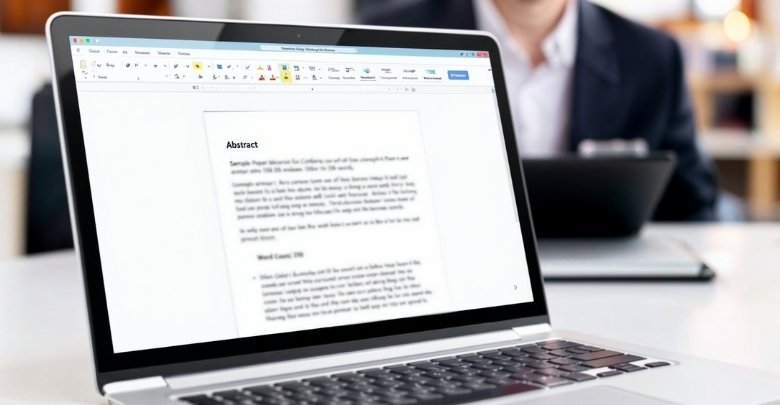One essential step in getting your research in front of more people is submitting a conference paper. It’s an opportunity to present your findings to experts in your field, but the process requires careful attention to detail. Many authors may wonder what specific rules they need to follow, and that’s where the conference paper submission guidelines come into play.
To submit a conference paper, follow these steps: register, adhere to formatting rules, meet word limits, include proper citations, and proofread thoroughly. Submit your paper before the deadline, ensure originality by checking for plagiarism, and be prepared to revise after peer review.
If you’re interested in a smooth submission process, reading through this article is essential. It provides you with a complete breakdown of the conference paper submission guidelines, offering all the information you need to ensure a successful submission.
Conference Paper Submission Guidelines for Authors
If you want your conference paper to be accepted, you must adhere to certain rules. Knowing formatting, deadlines, and submission platforms is key. Each conference has different rules, so reading the official instructions is a must. If you’re preparing your paper, follow these steps to make sure it meets all requirements.
Step 1. Register for the Conference
Some conferences require authors to register before submitting. Registration fees may apply, so check the requirements in advance. There are a lot of upcoming conferences available, which provide discounts for early registration. Keeping track of these details ensures that your paper submission goes smoothly and avoids any last-minute registration issues.
Step 2. Check Submission Requirements
Every conference has its own rules, including word limits, formatting, and reference styles. Make sure you review the guidelines carefully to avoid last-minute issues that could affect your submission. Some conferences may also require specific font sizes, spacing, or even a particular document format, so be thorough in checking every detail.
Step 3. Follow the Formatting Guidelines
Most conferences require papers to follow a standard format, such as IEEE or APA. Download the template provided by the organizers and structure your paper accordingly. This ensures uniformity across all submissions. Ignoring these guidelines can lead to disqualification, so always double-check your paper’s layout before submission.
Step 4. Meet the Word and Page Limit
There’s usually a restriction on the number of pages or words. Exceeding the limit may result in rejection. Keep your content concise and relevant while ensuring it stays within the allowed length. If your paper is too long, revise it by removing redundant details while maintaining clarity. If it’s too short, ensure you’ve fully explained the key points.
Step 5. Include Proper Citations
Referencing sources correctly is crucial to avoid plagiarism. Use the specified citation style and double-check all references before submitting. Automated tools can help ensure accuracy in formatting. Improper citations or missing references can negatively affect the credibility of your research and may even lead to outright rejection by the review panel.
Step 6. Proofread and Edit Carefully
Spelling and grammar mistakes can reduce the credibility of your paper. Before submission, proofread thoroughly or use professional editing tools. Getting feedback from a peer can also be helpful. Editing ensures that your work is clear, polished, and professional, which increases the likelihood of acceptance by the conference committee.
Step 7. Submit Before the Deadline
Late submissions are usually not accepted. Mark the deadline on your calendar and submit your paper at least a day early. This avoids technical issues that could delay your submission. Many submission portals experience heavy traffic near deadlines, so early submission reduces stress and helps ensure a successful upload.
Step 8. Check for Plagiarism
Most conferences check papers for originality. Running your paper through plagiarism detection software ensures it meets ethical standards. Avoid copying text directly and always paraphrase properly. Even unintentional plagiarism can disqualify your submission, so verifying originality before submission is a crucial step in the process.
Step 9. Prepare for Review Feedback
After submission, your paper will go through a review process. Be prepared to make revisions based on feedback. Addressing comments carefully improves the chances of your paper being accepted. Reviewers often suggest crucial improvements, and responding to their feedback professionally can make your paper stronger and more refined.
Although submitting a paper requires work, your chances of success are increased if you follow these guidelines. Always read the guidelines properly and prepare your submission well in advance to avoid unnecessary stress. Careful planning, thorough proofreading, and adherence to guidelines make the submission process smooth and more effective.
What Are the Common Formatting Mistakes in Conference Papers?
A conference paper’s formatting greatly influences how it is viewed. Mistakes in layout, citation styles, or visual elements can distract from the core content and make the paper less effective. Let’s take a closer look at some common formatting mistakes and how to avoid them.
Inconsistent Margins
Uneven margins often occur when authors forget to check the conference’s formatting guidelines. Margins that differ from the required specifications can make the paper look unprofessional and harder to read. Double-checking the page layout settings and ensuring margins are the same throughout the paper is a simple way to maintain a clean, polished appearance.
Incorrect Font Styles
Mixing fonts or using unapproved font sizes can break the uniform look of the paper. Inconsistent font choices can distract readers and reduce the overall clarity of the content. Sticking to one font family and following the conference’s font size recommendations ensures that the paper remains visually consistent and easy to read.
Misaligned Headings
Headings serve as signposts for the reader, guiding them through the paper’s structure. Misaligned headings can make navigation confusing and disrupt the logical flow of the document. Ensuring that headings are consistently aligned and formatted—such as using the same size, bolding, or placement—makes the paper more reader-friendly and helps highlight key sections.
Unclear Tables and Figures
Tables and figures can quickly become confusing if they lack clear labels or consistent formatting. Overcrowded tables, charts with inconsistent styles, or figures missing descriptive captions can leave readers guessing. Using straightforward labels and providing captions that explain the data in each visual element helps clarify the findings and ensures the information supports the main text effectively.
Improper Citation Formatting
Citations that don’t follow the required style can weaken the paper’s credibility. Forgetting to italicize titles, inconsistently using page numbers, or failing to provide complete publication details are common errors. Ensuring that all citations align with the conference’s style not only makes the paper more professional but also allows readers to easily trace the sources.
Fixing these formatting issues enhances the readability and professionalism of your conference paper in addition to giving it a polished appearance. By focusing on these details, you can ensure that your research gets the attention it deserves.
What Factors Determine the Best Methodology for a Conference Paper?
For a conference paper, selecting the appropriate methodology is essential since it influences the way data is gathered, examined, and interpreted. The methodology not only impacts the quality of your findings but also determines how your research is perceived by the academic community. Let’s explore the factors that influence this decision.
Research Goals
Your research objectives should be the first step in determining your methodology. If your goal is to explore relationships or test hypotheses, quantitative methods work best. However, if the aim is to understand experiences or gather insights, qualitative methods might be a better fit for the study.
Available Data
The type of data you can access plays a major role in choosing the correct methodology. Quantitative research requires numerical data, while qualitative research relies on descriptive or narrative data. In some cases, understanding qualitative and quantitative research helps determine which method aligns better with your available resources.
Scope of Study
How wide or narrow your research scope will be affects the methodology you choose. A broad study with large datasets often leans toward quantitative methods, while a more focused, in-depth analysis of a small group of participants might require qualitative research. Carefully considering your study’s scope ensures an appropriate method.
Time Constraints
Your time frame can limit which methodology is feasible. Quantitative research often requires substantial time for data collection and analysis, while qualitative research can sometimes be quicker. Being mindful of your deadlines ensures that you select a method that fits within the time available for your research.
Audience Expectations
Considering the expectations of your conference audience is essential. Certain conferences may prioritize quantitative data for its objective nature, while others may prefer qualitative methods that provide detailed insights. Adapting your methodology to suit the conference’s theme or expectations can help increase the likelihood of acceptance.
Selecting the right methodology for your conference paper is a balance between research goals, available data, and time constraints. A well-chosen methodology ensures that your findings are relevant and that your paper resonates with your intended audience.
Tips to Cite Sources Correctly in a Conference Paper
In a conference paper, properly citing sources is essential to upholding academic integrity and giving your arguments validity. It shows respect for prior research and allows readers to trace the information back to its original source. Here are some essential tips for proper citation in conference papers.
- Follow Citation Style: Ensure that you use the citation style required by the conference, such as APA, MLA, or IEEE. Adhering to a specific format shows attention to detail.
- Cite All Sources: Every time you reference someone else’s work, make sure to include a citation. This includes direct quotes, paraphrased ideas, and any supporting data used in your paper.
- Use In-text Citations: For each source you reference in the body of your paper, provide an in-text citation. This allows readers to easily connect ideas to their sources.
- Avoid Plagiarism: Never present someone else’s ideas as your own. Always attribute information accurately, and when in doubt, err on the side of caution by citing the source.
- List References Properly: Include a comprehensive reference list at the end of your paper. Make sure each entry matches the format of the citation style used, including authors, titles, and publication details.
- Be Consistent: Consistency is key when citing sources. Ensure that you apply the citation rules uniformly throughout your paper, including formatting for each type of reference.
- Use Citation Tools: Citation management tools like Zotero or EndNote can help organize your sources and format them correctly. These tools ensure that citations are consistent and correctly applied.
Proper citation not only enhances the credibility of your work but also strengthens your argument by showing a well-researched foundation. Following the correct guidelines and maintaining consistency throughout your paper will ensure its academic integrity.
How Does Abstract Length Impact the Acceptance of a Conference Paper?
When submitting a conference paper, the length of the abstract plays a significant role in its acceptance. The abstract serves as a summary of your research and must capture the essence of your work concisely. Knowing the delicate balance between presenting enough information and keeping it short can make a difference. To gain more insight, explore how abstract length can influence your paper’s approval below.
Relevance of Abstract Length
The length of the abstract impacts its effectiveness. An abstract that’s too brief might not provide enough information, leaving readers unclear about your research’s purpose and results. On the other hand, an abstract that’s too long might lose the reader’s attention. Finding the ideal length ensures you communicate your research clearly without confusing the reviewer.
Specific Requirements
Each conference typically sets word limits for abstracts. It’s essential to meet these limits, as ignoring them can negatively affect your submission. By keeping the abstract within the specified range, you demonstrate respect for the guidelines and show that you can present your research efficiently while adhering to the conference’s expectations.
Key Information in the Abstract
Focusing on the essential components, such as objectives, methods, and results, is vital when crafting an abstract. Including too many details can overwhelm the reader. Furthermore, understanding the differences between abstract and extended abstract can guide you in determining how much information to include.
Clarity and Precision
A concise abstract is effective only if it is clear and easy to understand. Avoid using overly technical language or vague descriptions. Focus on communicating your research in a straightforward manner that conveys the necessary details. This precision not only helps the reader grasp the content but also boosts your chances of acceptance.
Focused Structure
Readers can more easily comprehend your research when the abstract is well-structured. Begin by stating the purpose, followed by the methods, key results, and concluding remarks. This logical flow aids reviewers in assessing the quality and relevance of your work. An abstract with a clear structure enhances your paper’s chances of acceptance by offering a focused overview.
A well-written abstract that is clear and succinct, contains pertinent details and is the ideal length has a better chance of getting accepted to conferences. Always keep the audience in mind while preparing your abstract.
FAQs About Conference Paper Submission Guidelines
Below are frequently asked questions about conference paper submission guidelines. These questions address additional aspects not covered above, offering practical insights and advice. Review these answers to enhance your understanding and improve your submission process for better outcomes.
How Do I Know If My Conference Paper Is Accepted?
After submission, the conference organizers will typically notify you of acceptance or rejection within a specified period. Keep track of submission deadlines and check the email associated with your submission. If no notification is received by the deadline, it’s advisable to contact the organizers for an update.
Can I Submit a Paper That Has Been Previously Published?
Many conferences do not accept papers that have already been published elsewhere, including online or in journals. However, some conferences allow previously published papers, as long as they are not under copyright or do not conflict with the event’s guidelines. Always verify the conference’s policy on prior publications before submitting.
What Should I Include in the Abstract for Submission?
An abstract should provide a concise summary of your research, including the problem statement, methodology, main findings, and conclusions. Keep it clear and precise. Make sure it highlights the unique contribution of your work and aligns with the conference theme. Ensure that the abstract fits within the word limit provided.
How Do I Choose the Right Keywords for My Paper?
Keywords should reflect the core topics and themes of your paper, making it easier for reviewers and attendees to identify its relevance. Choose terms that are specific and commonly used in your field. Ensure that the keywords align with the research methods or theories discussed in the paper.
Is There a Word Limit for Conference Paper Submissions?
Most conferences have strict word or page limits for paper submissions, which are often specified in their guidelines. Exceeding these limits may lead to rejection. Be sure to review the conference rules and adjust your paper’s length accordingly. If your paper is too long, cut down on less essential sections while maintaining clarity.
Do I Need to Include References in the Paper?
Yes, including references is essential for supporting your arguments and providing context to your findings. Follow the citation style required by the conference, such as APA, MLA, or IEEE. Ensure all references are formatted correctly and listed in the bibliography section according to the specified guidelines.
How Should I Submit Visuals, Tables, and Figures in My Paper?
Most conferences provide guidelines on how to submit visuals, tables, and figures. Typically, these elements should be embedded in the text, clearly labeled, and referenced accordingly. Make sure the resolution is high enough for clarity and ensure that they are integrated with the paper’s content and not added as separate files.
What Should I Do If I Need to Make Changes After Submission?
If you need to make changes after submission, check the conference guidelines to see if revisions are allowed. Some conferences permit revisions before the final deadline. If changes are required after submission, contact the organizers or conference chair as soon as possible to inquire about the process for resubmission or modifications.
What Happens After My Paper Is Accepted?
After acceptance, you may be asked to present your paper at the conference. You will typically receive instructions regarding the presentation format, session details, and further deadlines. You may also need to submit a final version of the paper, incorporating any reviewer feedback or revisions before the presentation day.
Final Word
The likelihood that your paper will be accepted can be greatly increased by being aware of the specific steps and prerequisites for submitting your research. Following the proper steps ensures that your work aligns with the conference’s standards and expectations. By staying informed and adhering to the submission rules, you can easily navigate the conference paper submission guidelines.
To wrap up, remember to review the conference requirements carefully, check your formatting, and ensure your content aligns with the theme. Proofread your paper multiple times and aim for clarity and conciseness. Best of luck in your submission process, and may your hard work be rewarded with a successful acceptance!








